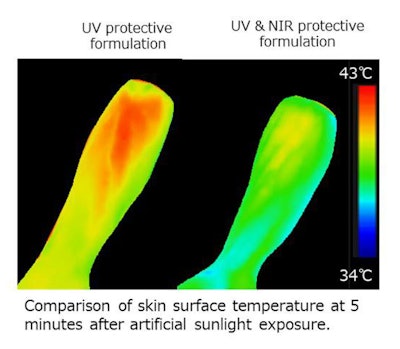
Kao Corp. recently revealed findings on an approach to reduce the burning sensation of near-infrared (NIR) heat from sun exposure by selective scattering this wavelength.
According to the company's Skin Care Research Laboratory and Processing Development Research Laboratory, by controlling the thickness of titanium flakes, researchers were able to scatter NIR rays in a highly precise and efficient manner. These findings were presented at the 85th meeting of the Society of Cosmetic Chemists of Japan (SCCJ), where Kao was awarded for best presentation.
Consumer Need
In a survey conducted by the company, 49% of respondents reported feeling discomfort such as skin "tingling" and "burning" when exposed to strong sunlight that could not be prevented by wearing sunscreen. As such, the researchers focused on the NIR component of sunlight, and experimental results confirmed an elevation in skin's surface temperature by 5-6°C within approximately 5 min of exposure to direct sun rays.
In addition, skin temperature surpassed 40°C (104°F) in a hot environment with an outside air temperature greater than 28°C (82.4°F). And, according to the researchers, when skin's surface temperature increases to ~42°C (107.6°F), sensory receptors are activated, causing the sensation of pain.
NIR Scattering
A variety of materials was tested for NIR blocking but no significantly effective solution was identified. Thus, the company's focus shifted toward principles related to light wave interference, and efficacy was ultimately attained by controlling the thickness of thin titanium dioxide flakes.
For the experiments, sunscreen formulations including an NIR-protective material combined with a UV protection formulation, and a conventional sunscreen formulation were applied to subjects' forearms for comparison, along with an untreated control. Following exposure to artificial sunlight, changes in skin surface temperature were determined.
The average temperature of skin in the untreated control was elevated by 6.5°C after 5 min of exposure. Skin treated with conventional UV protective formulation also increased in a similar manner. In contrast, the average skin temperature in the NIR formulation was 5.5°C.
 Evaluations of heat and burning sensations after 5 min of exposure also were performed. Findings, as shown via visual analog scale (VAS) scores, were significantly lower in the NIR-treated group.
Evaluations of heat and burning sensations after 5 min of exposure also were performed. Findings, as shown via visual analog scale (VAS) scores, were significantly lower in the NIR-treated group.Conclusions
Kao concluded these results confirm this new approach reduced both skin surface temperature increase and the sensation of heat caused by exposure to sunlight. The findings will be implemented for further sun protection developments.










